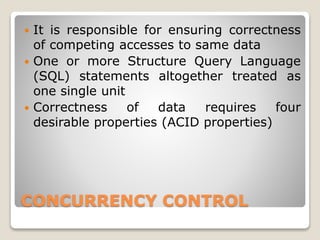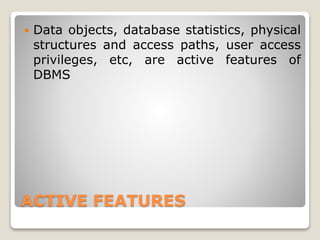Database management system
- 2. DATA Known facts that can be stored or recorded is called data PERSISTENT DATA: It continues to exist even, when the system is not active TRANSIENT DATA: it is created while an application is running and not needed, when the application has been terminated.
- 3. DATABASE Database is a collection of related data with a logically coherent structure with some inherent meaning, some specific purposes and for an intended group of users and applications It is a physical organization of varying complexity and size
- 4. BASIC CONCEPT OF DBMS Define the structure of a database Manage the storage of data, safely for long periods of time, on some storage medium controlled by DBMS Manipulate a database, with efficient user interfaces to query the database Manage database usage for users with their access rights, performance optimization, sharing of data among several users, security from accidents or unauthorized use Monitor and analyse database usage
- 5. KEY PEOPLE INVOLVED IN A DBMS DBMS IMPLEMENTER: Person who builds system DATABASE DESIGNER: Person responsible for preparing external schemas for applications, identifying and integrating user needs into a conceptual schema DATABASE APPLICATION DEVELOPER: Person responsible for implementing database application programs that facilitate data access for end users
- 6. KEY PEOPLE INVOLVED IN A DBMS DATABASE ADMINISTRATOR: Person responsible for defining the internal schema, sub-schemas (with database designers) and specifying mappings between schemas, monitoring database usage and supervising DBMS functionality CASUAL USERS AS END USERS: Occasional unanticipated access to database PARAMETRIC USERS AS END USERS: Users who query and update the database through fixed programs
- 7. SCHEMA/INTENSION Schema comprises the definition of domains for data elements (attributes) and the specification of constraints, to define the data structure part of the schema Intension is a constant value that gives the name, structure of table and the constraints laid on it Schemas don’t change frequently
- 8. INSTANCE/EXTENSION Databases change over time because records are inserted and deleted frequently The collection of information stored in the database at a particular moment is called an instance of the database while extension means the number of tuples present in a table at any instance This is dependent on time
- 9. DATA ABSTRACTION Hiding the complexity from users through several levels of abstraction, to simplify users’ interactions with the system, as many database systems users are not computer trained Three levels of data abstraction: i) Physical level ii) Logical level iii) View level
- 10. PHYSICAL LEVEL Physical level is the lowest level of abstraction and describes how the data are actually stored and complex low level data structures in detail At the physical level, an employee record can be described as a block of consecutive storage locations
- 11. LOGICAL LEVEL Logical level is the next higher level of abstraction and describes what data are stored and what relationships exist among those data At logical level, each such record is described by a type definition and the interrelationship of these record types is defined as well Database administrators usually work at this level of abstraction
- 12. VIEW LEVEL View level is the highest level of abstraction and describes only part of the entire database and hides the details of the logical level At this level, several views of the database are defined and database users see these views The views also provide a security mechanism to prevent users from accessing certain parts of the database
- 13. FUNCTIONALITY OF DBMS Concurrency control Backup and recovery Redundancy management Access control Performance optimisation Metadata management Active features (rules, triggers)
- 14. CONCURRENCY CONTROL It is responsible for ensuring correctness of competing accesses to same data One or more Structure Query Language (SQL) statements altogether treated as one single unit Correctness of data requires four desirable properties (ACID properties)
- 15. BACKUP AND RECOVERY Facilities for recovering from hardware and software failures If the computer system fails during a complex update program, the database must be restored to its state before the program started, or the program must be resumed, where it was interrupted so that its full effect is recorded in database In a multiuser environment, it is more complex and important
- 16. REDUNDANCY MANAGEMENT Redundancy means storing several copies of the same data Redundant entries are frequent in traditional file processing; a goal of the database approach was to control redundancy as much as possible Problems with redundancy includes wastage of storage space, duplication of effort to perform a single conceptual update, danger of introducing inconsistency, if multiple updates are not coordinated
- 17. ACCESS CONTROL Responsible for enforcing security and authorisation (e.g., who can create new bank accounts) and data (e.g., which bank accounts one can see) It is all about who accesses what data, to do what, when, from where, etc
- 18. PERFORMANCE OPTIMIZATION Performing physical reorganizations to enhance performance, e.g., adding index, dropping index, sorting file Performance optimization is made possible by physical data independence and high level data models with user programs which can be optimized through DBMS software
- 19. METADATA MANAGEMENT Metadata means data about data It involves storing of information about other information With different types of media being used, references to the location of the data can allow management of diverse repositories
- 20. ACTIVE FEATURES Data objects, database statistics, physical structures and access paths, user access privileges, etc, are active features of DBMS
- 21. THANK YOU!!!





















